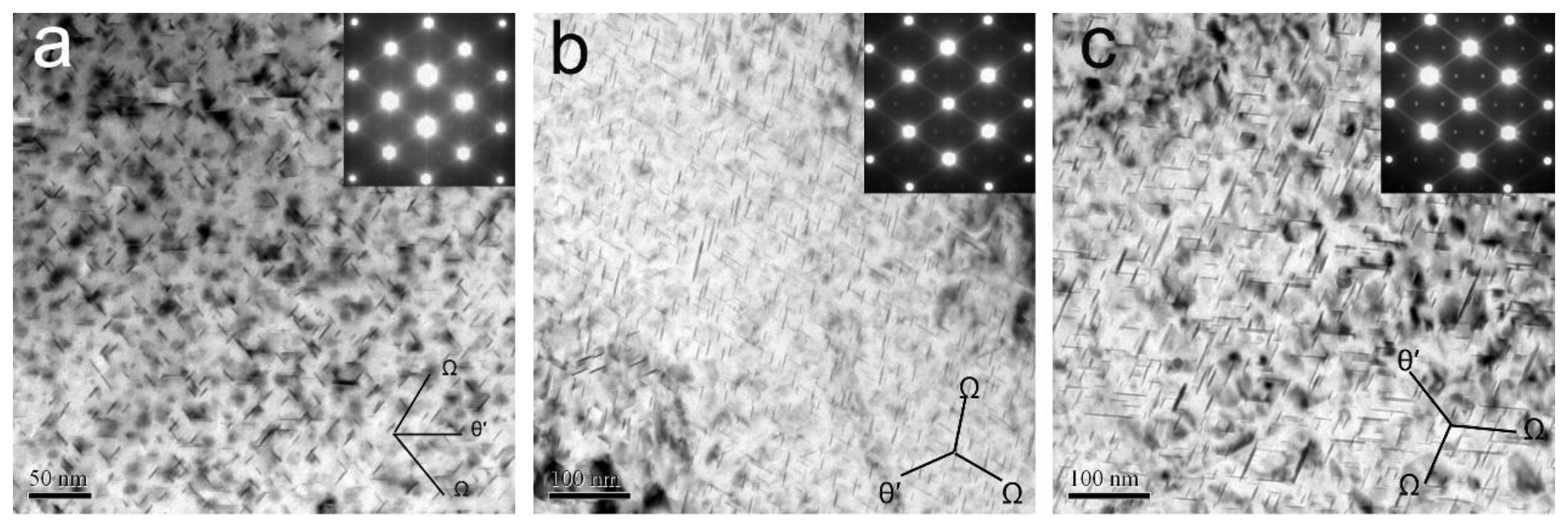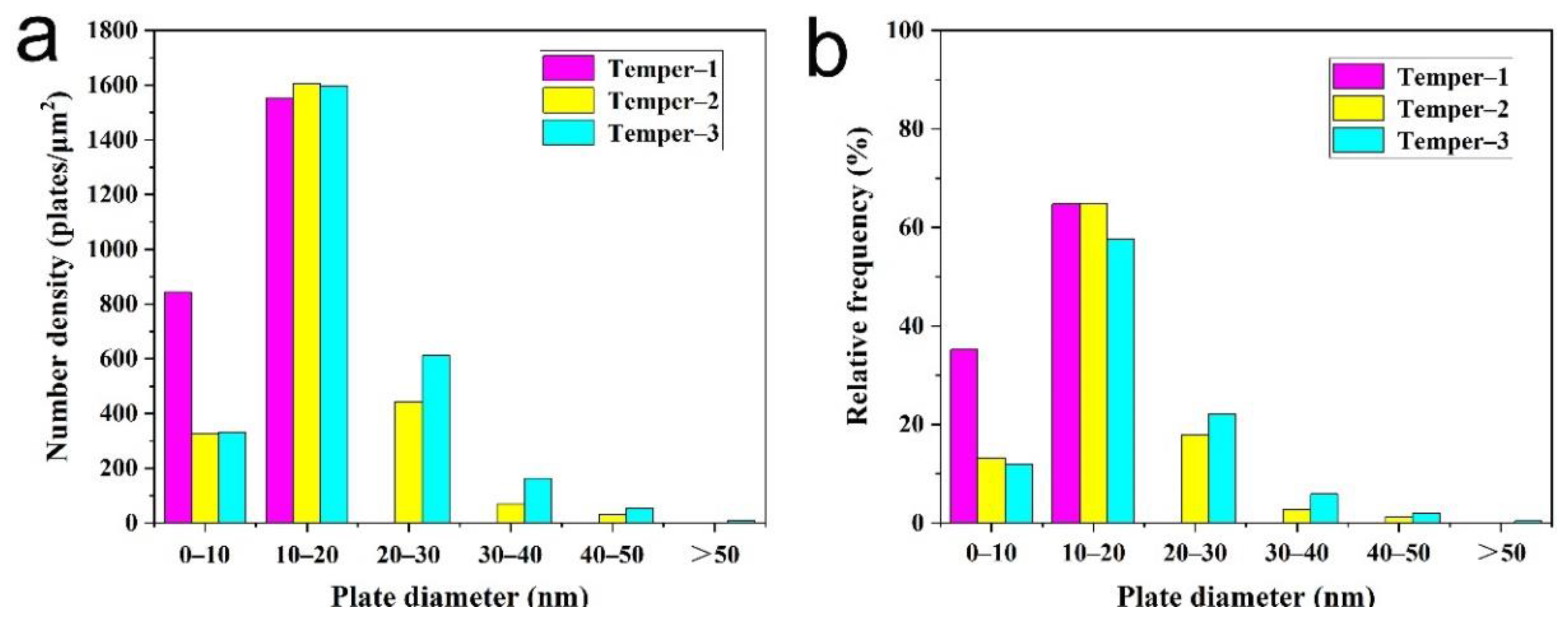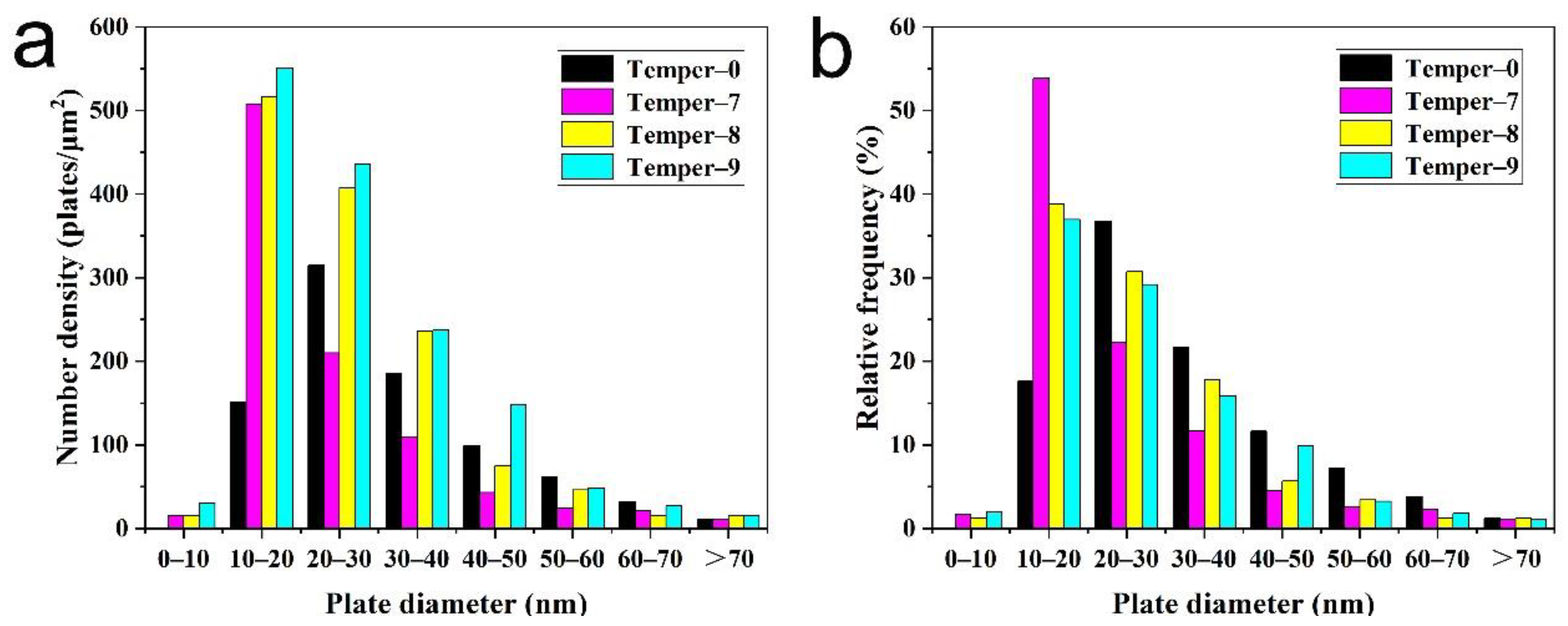Pre-Aging Effect on the Formation of Ω Phase and Mechanical Properties of the Al-Cu-Mg-Ag Alloy
Abstract
:1. Introduction
2. Materials and Methods
3. Results
3.1. Mechanical Properties of Samples with Different Heat Treatments
3.2. TEM Characterization for Different Heat Treatments
3.2.1. TEM Characterization of the Studied Alloys after the Pre-Aging Process
3.2.2. TEM Characterization of the Studied Alloys Treated with Pre-Strain after Pre-Aging
3.2.3. TEM Characterization of the Studied Alloys Treated with the Final Heat Treatment Process
3.3. Quantitative TEM Results of Ω Plates for Different Heat Treatments
4. Discussion
4.1. The Effect of Pre-Strain on the Precipitation Behavior of the Studied Alloy
4.2. The Effect of Pre-Aging on the Precipitation Behavior and Mechanical Properties of the Studied Alloy
4.3. The Effect of the Pre-Aging Temperature on the Precipitation Behavior and Mechanical Properties of the Studied Alloy
5. Conclusions
- (1)
- Pre-strain decreased alloy strength. This negative effect could be reduced by introducing pre-aging treatment. Furthermore, pre-aging with a higher temperature was more beneficial to alloy strength.
- (2)
- Pre-strain inhibited the formation of Ω phases. When pre-aging was applied, the pre-precipitated Ω phase could be retained and grew in the subsequent aging process. This reduced the adverse effect of pre-strain.
- (3)
- A higher pre-aging temperature could promote more pre-precipitated Ω phase, finally increasing the number density of Ω phases in the matrix. Moreover, the precipitated Ω phase consumed solute atoms, which indicated that a higher pre-aging temperature could expend more solute atoms and less residual solute atoms remained in the matrix. Thus, the formation of clusters by the segregation of solute atoms were less affected by pre-strain.
Author Contributions
Funding
Institutional Review Board Statement
Informed Consent Statement
Data Availability Statement
Conflicts of Interest
References
- Polmear, I.J.; Couper, M.J. Design and development of an experimental wrought aluminum alloy for use at elevated temperatures. Metall. Trans. A 1988, 19, 1027–1035. [Google Scholar] [CrossRef]
- Oguocha, I.N.A.; Yannacopoulos, S. Precipitation and dissolution kinetics in Al-Cu-Mg-Fe-Ni alloy 2618 and Al-alumina particle metal matrix composite. Mater. Sci. Eng. A 1997, 231, 25–33. [Google Scholar] [CrossRef]
- Polmear, I.; Pons, G.; Barbaux, Y.; Octor, H.; Sanchez, C.; Morton, A.; Borbidge, W.; Rogers, S.A. After Concorde: Evaluation of creep resistant Al-Cu-Mg-Ag alloys. J. Mater. Sci. Technol. 1999, 15, 861–868. [Google Scholar] [CrossRef]
- Hutchinson, C.R.; Fan, X.; Pennycook, S.J.; Shiflet, G.J. On the origin of the high coarsening resistance of Ω plates in Al-Cu-Mg-Ag alloys. Acta Mater. 2001, 49, 2827–2841. [Google Scholar] [CrossRef]
- Muddle, B.; Polmear, I. The precipitate Ω phase in Al-Cu-Mg-Ag alloys. Acta Met. 1989, 37, 777–789. [Google Scholar] [CrossRef]
- Ringer, S.P.; Hono, K.; Polmear, I.J.; Sakurai, T. Nucleation of precipitates in aged Al-Cu-Mg-(Ag) alloys with high Cu:Mg ratios. Acta Mater. 1996, 44, 1883–1898. [Google Scholar] [CrossRef]
- Knowles, K.M.; Stobbs, W.M. The structure of {111} age-hardening precipitates in Al-Cu-Mg-Ag alloys. Acta Crystallogr. Sect. B Struct. Sci. 1988, 44, 207–227. [Google Scholar] [CrossRef]
- Ringer, S.P.; Yeung, W.; Muddle, B.C.; Polmear, I.J. Precipitate stability in Al-Cu-Mg-Ag alloys aged at high temperatures. Acta Metall. Mater. 1994, 42, 1715–1725. [Google Scholar] [CrossRef]
- Bai, S.; Ying, P.; Liu, Z.; Wang, J.; Li, J. Quantitative transmission electron microscopy and atom probe tomography study of Ag-dependent precipitation of Ω phase in Al-Cu-Mg alloys. Mater. Sci. Eng. A 2017, 687, 8–16. [Google Scholar] [CrossRef]
- Hono, K.; Sano, N.; Babu, S.S.; Okano, R.; Sakurai, T. Atom probe study of the precipitation process in Al-Cu-Mg-Ag alloys. Acta Metall. Mater. 1993, 41, 829–838. [Google Scholar] [CrossRef]
- Zhou, X.; Liu, Z.; Bai, S.; Liu, M.; Ying, P. The influence of various Ag additions on the nucleation and thermal stability of Ω phase in Al-Cu-Mg alloys. Mater. Sci. Eng. A 2013, 564, 186–191. [Google Scholar] [CrossRef]
- Zhou, Y.; Liu, Z.; Bai, S.; Ying, P.; Lin, L. Effect of Ag additions on the lengthening rate of Ω plates and formation of σ phase in Al-Cu-Mg alloys during thermal exposure. Mater. Charact. 2017, 123, 1–8. [Google Scholar] [CrossRef]
- Bai, S.; Zhou, X.; Liu, Z.; Xia, P.; Liu, M.; Zeng, S. Effects of Ag variations on the microstructures and mechanical properties of Al-Cu-Mg alloys at elevated temperatures. Mater. Sci. Eng. A 2014, 611, 69–76. [Google Scholar] [CrossRef]
- Bai, S.; Liu, Z.; Zhou, X.; Xia, P.; Liu, M. Stress-induced thickening of Ω phase in Al-Cu-Mg alloys containing various Ag additions. Mater. Sci. Eng. A 2014, 589, 89–96. [Google Scholar] [CrossRef]
- Bakavos, D.; Prangnell, P.; Bes, B.; Eberl, F. The effect of silver on microstructural evolution in two 2xxx series Al-alloys with a high Cu:Mg ratio during ageing to a T8 temper. Mater. Sci. Eng. A 2008, 491, 214–223. [Google Scholar] [CrossRef]
- Ringer, S.; Muddle, B.C.; Polmear, I.J. Effects of cold work on precipitation in Al-Cu-Mg-(Ag) and Al-Cu-Li-(Mg-Ag) alloys. Metall. Mater. Trans. A 1995, 26, 1659–1671. [Google Scholar] [CrossRef]
- Li, Q.; Shenoy, R.N. DSC and TEM characterizations of thermal stability of an Al-Cu-Mg-Ag alloy. J. Mater. Sci. 1997, 32, 3401–3406. [Google Scholar] [CrossRef]
- Chen, Y.-T.; Lee, S.-L.; Bor, H.-Y.; Lin, J.-C. Effect of natural aging and cold working on microstructures and mechanical properties of Al-4.6Cu-0.5Mg-0.5Ag alloy. Metall. Mater. Trans. A 2013, 44, 2831–2838. [Google Scholar] [CrossRef]
- Bai, S.; Liu, Z.; Ying, P.; Wang, J.; Wang, A. Quantitative study of the solute clustering and precipitation in a prestretched Al-Cu-Mg-Ag alloy. J. Alloys Compd. 2017, 725, 1288–1296. [Google Scholar] [CrossRef]
- Bai, S.; Yi, X.; Liu, Z.; Wang, J.; Zhao, J.; Ying, P. The influence of preaging on the strength and precipitation behavior of a deformed Al-Cu-Mg-Ag alloy. J. Alloys Compd. 2018, 764, 62–72. [Google Scholar] [CrossRef]
- Lumley, R.N.; Polmear, I.J.; Morton, A.J. Interrupted aging and secondary precipitation in aluminum alloys. Mater. Sci. Technol. 2003, 19, 1483–1490. [Google Scholar] [CrossRef]
- Li, Y.; Liu, Z.; Bai, S.; Zhou, X.; Wang, H.; Zeng, S. Enhanced mechanical properties in an Al-Cu-Mg-Ag alloy by duplex aging. Mater. Sci. Eng. A 2011, 528, 8060–8064. [Google Scholar] [CrossRef]
- Vural, M.; Caro, J. Experimental analysis and constitutive modeling for the newly developed 2139-T8 alloy. Mater. Sci. Eng. A 2009, 520, 56–65. [Google Scholar] [CrossRef]
- Ünlü, N.; Gable, B.M.; Shiflet, G.J.; Starke, E.A. The effect of cold work on the precipitation of Ω and θ′ in a ternary Al-Cu-Mg alloy. Metall. Mater. Trans. A 2003, 34, 2757–2769. [Google Scholar] [CrossRef]
- Liu, X.-Y.; Wang, Z.-P.; Li, Q.-S.; Zhang, X.-L.; Cui, H.-X. Effects of pre-deformation on microstructure and properties of Al-Cu-Mg-Ag heat-resistant alloy. J. Cent. South Univ. 2017, 24, 1027–1033. [Google Scholar] [CrossRef]
- Gazizov, M.; Kaibyshev, R. Effect of over-aging on the microstructural evolution in an Al-Cu-Mg-Ag alloy during ECAP at 300 C. J. Alloys Compd. 2012, 527, 163–175. [Google Scholar] [CrossRef]
- Gazizov, M.; Kaibyshev, R. The precipitation behavior of an Al-Cu-Mg-Ag alloy under ECAP. Mater. Sci. Eng. A 2013, 588, 65–75. [Google Scholar] [CrossRef]
- Gazizov, M.; Kaibyshev, R. Effect of pre-straining on the aging behavior and mechanical properties of an Al-Cu-Mg-Ag alloy. Mater. Sci. Eng. A 2015, 625, 119–130. [Google Scholar] [CrossRef]
- Khalaj, G.; Khalaj, M.J.; Nazari, A. Microstructure and hot deformation behavior of AlMg6 alloy produced by equal-channel angular pressing. Mater. Sci. Eng. A 2012, 542, 15–20. [Google Scholar] [CrossRef]
- Jandaghi, M.R.; Pouraliakbar, H.; Gharah Shiran, M.K.; Khalajd, G.; Shirazie, M. On the effect of non-isothermal annealing and multi-directional forging on the microstructural evolutions and correlated mechanical and electrical characteristics of hot-deformed Al-Mg alloy. Mater. Sci. Eng. A 2016, 657, 431–440. [Google Scholar] [CrossRef]
- Cassada, W.A. Heterogeneous Precipitation in Al-Li-Cu Alloys. Ph.D. Dissertation, University of Virginia, Charlottesville, VA, USA, 1987. [Google Scholar]
- Liu, M.; Klobes, B.; Maier, K. On the age-hardening of an Al-Zn-Mg-Cu alloy: A vacancy perspective. Scr. Mater. 2011, 64, 21–24. [Google Scholar] [CrossRef]
- Marceau, R.K.; Sha, G.; Lumley, R.N.; Ringer, S.P. Evolution of solute clustering in Al-Cu-Mg alloys during secondary ageing. Acta Mater. 2010, 58, 1795–1805. [Google Scholar] [CrossRef]
- Peng, J.; Bahl, S.; Shyam, A.; Haynes, J.A.; Shin, D. Solute-vacancy clustering in aluminum. Acta Mater. 2020, 196, 747–758. [Google Scholar] [CrossRef]
- Zhu, A.W.; Starke, E.A., Jr. Strengthening effect of unshearable particles of finite size: A computer experimental study. Acta Mater. 1999, 47, 3263–3269. [Google Scholar] [CrossRef]
- Nie, J.F.; Muddle, B.C. Microstructural design of high-strength aluminum alloys. J. Phase Equilibria 1998, 19, 543–551. [Google Scholar] [CrossRef]
- Nie, J.F.; Muddle, B.C. Comments on the “dislocation interaction with semicoherent precipitates (Ω phase) in deformed Al-Cu-Mg-Ag alloy. Scr. Mater. 2000, 42, 409–413. [Google Scholar] [CrossRef]
- Macchi, C.; Tolley, A.; Giovachini, R.; Polmear, I.; Somoza, A. Influence of a microalloying addition of Ag on the precipitation kinetics of an Al-Cu-Mg alloy with high Mg:Cu ratio. Acta Mater. 2015, 98, 275–287. [Google Scholar] [CrossRef]
- Gazizov, M.R.; Boev, A.O.; Marioara, C.D.; Holmestad, R.; Aksyonov, D.A.; Gazizova, M.Y.; Kaibyshev, R.O. Precipitate/matrix incompatibilities related to the {111}Al Ω plates in an Al-Cu-Mg-Ag alloy. Mater. Charact. 2021, 182, 111586. [Google Scholar] [CrossRef]
- Gazizov, M.; Boev, A.; Marioara, C.; Holmestad, R.; Gazizova, M.; Kaibyshev, R. Edge interfaces of the Ω plates in a peak-aged Al-Cu-Mg-Ag alloy. Mater. Charact. 2022, 185, 111747. [Google Scholar] [CrossRef]
- Yang, S.; Zhao, X.; Chen, H.; Wilson, N.; Nie, J. Atomic structure and evolution of a precursor phase of Ω precipitate in an Al-Cu-Mg-Ag alloy. Acta Mater. 2022, 225, 117538. [Google Scholar] [CrossRef]






| Element | Cu | Mg | Ag | Mn | Ti | Zr | Al |
|---|---|---|---|---|---|---|---|
| 6.5 | 0.4 | 1.6 | 0.3 | 0.05 | 0.10 | Bal. |
| Temper | Solution Treatment | Pre-Aging | Pre-Strain | Secondary Aging |
|---|---|---|---|---|
| Temper-0 | 520 °C/2 h | None | 2.5% | 165 °C/16 h |
| Temper-1 | 520 °C/2 h | 165 °C/1 h | None | None |
| Temper-2 | 520 °C/2 h | 180 °C/1 h | None | None |
| Temper-3 | 520 °C/2 h | 190 °C/1 h | None | None |
| Temper-4 | 520 °C/2 h | 165 °C/1 h | 2.5% | None |
| Temper-5 | 520 °C/2 h | 180 °C/1 h | 2.5% | None |
| Temper-6 | 520 °C/2 h | 190 °C/1 h | 2.5% | None |
| Temper-7 | 520 °C/2 h | 165 °C/1 h | 2.5% | 165 °C/16 h |
| Temper-8 | 520 °C/2 h | 180 °C/1 h | 2.5% | 165 °C/12 h |
| Temper-9 | 520 °C/2 h | 190 °C/1 h | 2.5% | 165 °C/6 h |
| Tempers | Tensile Strength σb/MPa | Yield Strength σ0.2/MPa | Elongation (%) |
|---|---|---|---|
| Temper-0 | 508 ± 5 | 482 ± 5 | 8.6 ± 0.1 |
| Temper-1 | 429 ± 4 | 281 ± 7 | 23.4 ± 2.5 |
| Temper-2 | 502 ± 3 | 470 ± 4 | 9.1 ± 0.2 |
| Temper-3 | 527 ± 3 | 502 ± 1 | 8.3 ± 0.3 |
| Temper-4 | 416 ± 6 | 277 ± 5 | 24.0 ± 1.8 |
| Temper-5 | 495 ± 4 | 468 ± 3 | 9.3 ± 0.3 |
| Temper-6 | 524 ± 4 | 502 ± 2 | 8.3 ± 0.2 |
| Temper-7 | 523 ± 1 | 500 ± 1 | 8.1 ± 0.1 |
| Temper-8 | 533 ± 3 | 501 ± 5 | 7.2 ± 0.3 |
| Temper-9 | 540 ± 1 | 506 ± 4 | 6.8 ± 0.1 |
| Aging Treatments | Average Plate Diameter (nm) | Number Density (Plates/μm2) |
|---|---|---|
| Temper-1 | 11.0 | 2396 |
| Temper-2 | 16.4 | 2475 |
| Temper-3 | 17.9 | 2765 |
| Temper-4 | 10.7 | 1863 |
| Temper-5 | 15.7 | 2275 |
| Temper-6 | 17.8 | 2430 |
| Temper-0 | 32.2 | 854 |
| Temple-7 | 23.7 | 943 |
| Temper-8 | 26.0 | 1330 |
| Temper-9 | 26.5 | 1492 |
Publisher’s Note: MDPI stays neutral with regard to jurisdictional claims in published maps and institutional affiliations. |
© 2022 by the authors. Licensee MDPI, Basel, Switzerland. This article is an open access article distributed under the terms and conditions of the Creative Commons Attribution (CC BY) license (https://creativecommons.org/licenses/by/4.0/).
Share and Cite
Ying, P.; Lin, C.; Liu, Z.; Bai, S.; Levchenko, V.; Zhang, P.; Wu, J.; Yang, T.; Huang, M.; Yang, G.; et al. Pre-Aging Effect on the Formation of Ω Phase and Mechanical Properties of the Al-Cu-Mg-Ag Alloy. Metals 2022, 12, 1208. https://doi.org/10.3390/met12071208
Ying P, Lin C, Liu Z, Bai S, Levchenko V, Zhang P, Wu J, Yang T, Huang M, Yang G, et al. Pre-Aging Effect on the Formation of Ω Phase and Mechanical Properties of the Al-Cu-Mg-Ag Alloy. Metals. 2022; 12(7):1208. https://doi.org/10.3390/met12071208
Chicago/Turabian StyleYing, Puyou, Changhong Lin, Zhiyi Liu, Song Bai, Vladimir Levchenko, Ping Zhang, Jianbo Wu, Tao Yang, Min Huang, Gang Yang, and et al. 2022. "Pre-Aging Effect on the Formation of Ω Phase and Mechanical Properties of the Al-Cu-Mg-Ag Alloy" Metals 12, no. 7: 1208. https://doi.org/10.3390/met12071208
APA StyleYing, P., Lin, C., Liu, Z., Bai, S., Levchenko, V., Zhang, P., Wu, J., Yang, T., Huang, M., Yang, G., Liu, M., & Li, M. (2022). Pre-Aging Effect on the Formation of Ω Phase and Mechanical Properties of the Al-Cu-Mg-Ag Alloy. Metals, 12(7), 1208. https://doi.org/10.3390/met12071208






